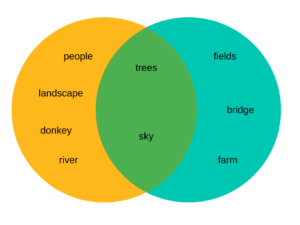In this section you will find activities which investigate two artworks side by side, asking learners to find similarities and differences.
Key Information
Pieter Bruegel the Elder, Landscape with Flight into Egypt, 1563
This painting depicts the story of the Holy Family (Mary on a donkey, holding the infant baby Jesus, being led by Joseph) fleeing Jerusalem under the rule of Herod, to Egypt.
The swooping panoramic landscape in this painting, depicted from an elevated viewpoint, is imaginary. It is thought to be inspired by Bruegel’s own journey to Italy, crossing the Alps.
The artist’s biographer Karl van Mander wrote:
“He swallowed up the mountains and rocks to throw them back up again… on canvases and panels.”
Although the painting depicts a story, the real focus is not on the people but on the landscape.

Paul Cézanne, Montagne Sainte-Victoire with Large Pine, c.1887
The Montagne Saint-Victoire is a mountain ridge which lies to the east of Aix-en-Province, Paul Cézanne’s hometown, in the south of France. Cézanne painted the mountain many times throughout his career. For him it came to symbolize home.
The landscape is based on Cézanne’s observations from a viewpoint overlooking the valley of the Arc river and is one of several versions he painted of the same view.
Here the branches of the pine trees shimmer in the breeze as they follow the contours of the mountain ridge. By using this device, Cézanne makes the distant mountain seem closer and larger. Whilst the landscape may feel timeless, the presence of the railway viaduct on the right would have been a strongly contemporary reference for viewers in the late 1880s.
Cezanne uses blocks of bold colour, with blues to create atmosphere and yellows and reds to reflect the light, suggesting the sunny warmth of the south of France.


Suggested Further Activities
Venn Diagram
Learners can create a Venn diagram to compare two artworks, noting elements unique to each artwork in the outer circles, and elements applicable to both artworks in the overlapping section.
Yellow section: What I can see in the left painting
Blue section: What I can see in the right painting
Green section: What I can see in both paintings
When learners feel confident in using this technique, you could introduce a third artwork, looking for similarities in all three works, similarities between two works and elements only applicable to the individual works.

You can use this technique to compare any of the artworks of your choice, including those featured in our ESOL resources, The Courtauld Collection and the collections of other museums and galleries.
Compare and Contrast in Everyday Life:
Higher level ESOL learners can apply the same investigation techniques to compare all sort of things that they encounter day to day. This might be their journey to college, a piece of music they enjoy or their favourite film, anything at all!
Learners should work in pairs, taking it in turns to describe the individual elements that make up their chosen thing, for example if they were comparing films they might describe what genre of film it is, whether it’s live action or animated, who the lead actors are etc. Learners will then work together to figure out whether there are any similarities between both things.





